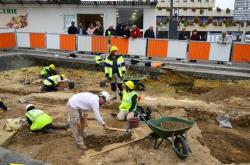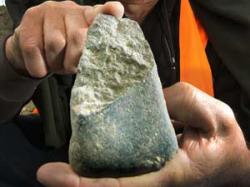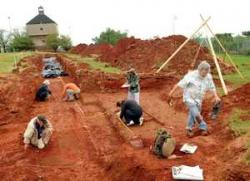13 OCTOBRE
INDI-UNI : ANTHROPOLOGY - ARCHAEOLOGY
INSCRIPTION 2011 – 2012 COURS A DISTANCE
REGISTRATION 2011 – 2012 ONLINE COURSES
FRANCE –  Joué - Une fouille prévue de longue date. « Nous savions qu'une église médiévale se trouvait ici, ainsi que le cimetière paroissial qui l'entourait, rappelle Pierre Papin, responsable de l'opération pour le service archéologique du conseil général. Les dates de fouilles ont été calées pour ne pas gêner le bon déroulement du chantier du tramway. Une fois les huit semaines de fouilles terminées, la plateforme sera installée. »
Joué - Une fouille prévue de longue date. « Nous savions qu'une église médiévale se trouvait ici, ainsi que le cimetière paroissial qui l'entourait, rappelle Pierre Papin, responsable de l'opération pour le service archéologique du conseil général. Les dates de fouilles ont été calées pour ne pas gêner le bon déroulement du chantier du tramway. Une fois les huit semaines de fouilles terminées, la plateforme sera installée. »
Les fondations qui se dégagent du chantier sont les restes de cette église du XI e ou XII e siècle, abandonnée en 1868. La sépulture se découvre également peu à peu. « L'emplacement de cette église était tombé dans l'oubli, il a été redécouvert dans le cadre des travaux du tramway. Des sources écrites nous permettent de situer approximativement la date d'origine de cette église. La fouille va permettre de préciser ces sources. »
Les fouilles sont réalisées conjointement entre le service de l'archéologique du conseil général (Sadil) et l'Inrap, l'Institut national de recherches archéologiques préventives. Dix archéologues - dont deux spécialisés en anthropologie pour la fouille des squelettes - un topographe, un gestionnaire du mobilier archéologique et des techniciens sont à l'oeuvre pour le ramassage des os et le prélèvement des squelettes, avant que ne démarre l'étude anthropologique des ossements. L'objectif sera alors de déterminer l'âge et le sexe des personnes enterrées ici, et éventuellement trouver les pathologies décelées.
http://www.lanouvellerepublique.fr/LOISIRS/Sports-et-loisirs/Fouilles-l-ancienne-eglise-de-Joue-revoit-le-jour
NOUVELLE ZELANDE –  Lyttleton - The discovery of a Maori adze beneath the demolished Lyttleton post office has provided physical evidence for an oral history dating back more than 800 years. The woodworking tool was found by archaeologists deep beneath the concrete foundations of the 1875 building on Norwich Quay that was demolished in September. Its discovery has prompted theories that early Maori settlers may have carved and launched waka on the site. Te Hapu O Ngai Te Wheke representative Rewi Couch said the adze gave physical proof to centuries-old tales. But until the artefacts were carbon-dated, an exact age of the settlement would not be known. "This might have been a launch site for waka," he said. "They might even have been building waka here; the trees were right down to the shoreline then. Historians have long known of Rapaki, the Maori village located under what is now Sutton Reserve, dating back roughly 800 to 1000 years. Due to the nature of the soil at the post office site, no evidence of wooden structures, including waka, remained as they would have rotted, Couch said. However, the midden showed evidence of fires, and a variety of food remains including paua shells, seal bones and fish bones. Couch said that showed that while Maori would not have lived for long periods on the site, it would have been used periodically for a number of years. It could have been used in seasonal visits by Maori from other parts of the South Island, possibly to hunt shark in the summer. Historic Places Trust Southern region Maori heritage adviser Helen Brown said the discovery was a "tangible reminder of the multiple layers of history". "Oral tradition indicates there has been a long-standing occupation of this area by Ngai Tahu, Kati Mamoe and Waitaha," Brown said.
Lyttleton - The discovery of a Maori adze beneath the demolished Lyttleton post office has provided physical evidence for an oral history dating back more than 800 years. The woodworking tool was found by archaeologists deep beneath the concrete foundations of the 1875 building on Norwich Quay that was demolished in September. Its discovery has prompted theories that early Maori settlers may have carved and launched waka on the site. Te Hapu O Ngai Te Wheke representative Rewi Couch said the adze gave physical proof to centuries-old tales. But until the artefacts were carbon-dated, an exact age of the settlement would not be known. "This might have been a launch site for waka," he said. "They might even have been building waka here; the trees were right down to the shoreline then. Historians have long known of Rapaki, the Maori village located under what is now Sutton Reserve, dating back roughly 800 to 1000 years. Due to the nature of the soil at the post office site, no evidence of wooden structures, including waka, remained as they would have rotted, Couch said. However, the midden showed evidence of fires, and a variety of food remains including paua shells, seal bones and fish bones. Couch said that showed that while Maori would not have lived for long periods on the site, it would have been used periodically for a number of years. It could have been used in seasonal visits by Maori from other parts of the South Island, possibly to hunt shark in the summer. Historic Places Trust Southern region Maori heritage adviser Helen Brown said the discovery was a "tangible reminder of the multiple layers of history". "Oral tradition indicates there has been a long-standing occupation of this area by Ngai Tahu, Kati Mamoe and Waitaha," Brown said.
http://tvnz.co.nz/national-news/ancient-maori-tool-found-in-old-lyttleton-post-office-4459812
ITALIE - Monte Testaccio - In the heart of Rome, senior Kelsey Bidwell spent two weeks uncovering ancient artifacts with the Monte Testaccio archaeological project. Monte Testaccio is one of the world’s largest archives of ancient Roman commerce and is located in one of the most popular areas of the city center, next to the shore of the Tiber River. Bidwell said she was working with artifacts from the third century when she discovered pottery from 200 A.D. Ancient Romans painted many of the pieces with writing, and a high percentage of the writing was in Latin, describing where the product came from with specific dates, she said. “Ninety-nine percent of the pottery on the site is amphorae shards,” said Antoni Pugi, Monte Testaccio’s team leader. “This is because the place was a specific dump for the trade of olive oil, used just for the amphorae from some specific port facilities related with that trade.” Pugi said the writing on the amphorae, a type of ceramic vase, revealed the weight of the container, the oil inside and the name of the trader, altogether giving an archive of economic documents dealing with Roman trade.
http://www.idsnews.com/news/story.aspx?id=83401
CHINE – Taxkorgan - Chinese archaeologists have discovered an unidentified cluster of tombs on the Pamirs Plateau, unveiling a new mystery on the crossroads of the ancient Silk Road. Eights tombs, each two meters in diameter, were arranged on a 100-meter-long and 50-meter-wide terrace, with lines of black stones and lines of white stones stretching alongside like rays, according to the archaeology team with the Chinese Academy of Social Sciences that found the tombs in Xinjiang's Taxkorgan Tajik Autonomous County, a border region neighboring Afghanistan and Pakistan, in October. "The tombs are peculiar. No similar ones had been detected before on the Pamirs Plateau, or even in all of Central Asia," team captain Wu Xinhua said, adding that the discovery shows a gap between their knowledge and studies, and previous findings along the Silk Road. Wu believes that the ray-like stone strings might imply sun worship, but he admitted his assumption lacked sufficient evidence. But the archaeology team is quite certain that people buried in the tombs had dignified social statuses as the black stones were carried from afar and the terrace for the tomb platform would have been a rare land resource in the area. Located at the intersection of eastern and western cultures, the tomb cluster could reflect a deep historical background, Wu said. A local archaeologist said local nomads spotted an additional three similar tomb clusters in the township where the archaeology team discovered the tombs with
http://news.xinhuanet.com/english2010/culture/2011-10/12/c_131187122.htm
PACIFIQUE Nord-Ouest - People have lived in the Pacific Northwest for over 10000 years, and archaeologists are searching our region for evidence these inhabitants left behind.
VIDEO = http://www.youtube.com/watch?v=oNkzctd-HzE
INDE – Golconda - The Aga Khan Trust for Culture (AKTC), which has beautified the Humayun Tomb complex at Delhi, has evinced keen interest to give a facelift to the world famous Qutub Shahi Tombs at Golconda.Trust director-general Louis Monreal, director Cameron Rashti and projects director Ritish Nanda visited the tombs on Wednesday to conduct a preliminary survey and study various aspects of the proposed integrated development programme, which would to be launched after obtaining necessary approvals from the state government.
http://timesofindia.indiatimes.com/city/hyderabad/Aga-Khan-panel-keen-to-beautify-Qutub-Shahi-tombs/articleshow/10334939.cms
USA –  – Fort Hawkins - The artifacts are the rich by-product of a dig meant to trace an outer palisade wall that surrounded Fort Hawkins during the War of 1812. The search began this week and continues through October. The 14-foot wooden wall around the 1808 fort was likely added to prevent the British from bombing the fort from the Ocmulgee River, said Fort Hawkins project coordinator Marty Willett. “We have one of the richest archaeological sites for the War of 1812 in America,” Willett said. As a U.S. Army headquarters, Fort Hawkins played a major role in that war. Elliott calls it “the Pentagon of the South” and said that at some points, more than 1,000 men -- as well as soldiers as young as 7 years old -- were stationed at the fort, which was also a major trading post. It’s the second phase of archaeological investigation at the fort by the LAMAR Institute, one of the leading archaeological firms in the Southeast. The first, completed in 2007, documented the fort’s footprint, for the first time discovering brick buildings, palisade walls and more. The dig may turn up other structures besides the palisade wall. The wall leads to what was once a second block house like the replica that stands on the opposite corner of the site now. The wall may also abut a later slave’s residence, from a plantation that was built on the site in 1828, and a possible Civil War earthen battery, Elliott said. Other features such as the fort’s interior buildings remain to be excavated in the future.
– Fort Hawkins - The artifacts are the rich by-product of a dig meant to trace an outer palisade wall that surrounded Fort Hawkins during the War of 1812. The search began this week and continues through October. The 14-foot wooden wall around the 1808 fort was likely added to prevent the British from bombing the fort from the Ocmulgee River, said Fort Hawkins project coordinator Marty Willett. “We have one of the richest archaeological sites for the War of 1812 in America,” Willett said. As a U.S. Army headquarters, Fort Hawkins played a major role in that war. Elliott calls it “the Pentagon of the South” and said that at some points, more than 1,000 men -- as well as soldiers as young as 7 years old -- were stationed at the fort, which was also a major trading post. It’s the second phase of archaeological investigation at the fort by the LAMAR Institute, one of the leading archaeological firms in the Southeast. The first, completed in 2007, documented the fort’s footprint, for the first time discovering brick buildings, palisade walls and more. The dig may turn up other structures besides the palisade wall. The wall leads to what was once a second block house like the replica that stands on the opposite corner of the site now. The wall may also abut a later slave’s residence, from a plantation that was built on the site in 1828, and a possible Civil War earthen battery, Elliott said. Other features such as the fort’s interior buildings remain to be excavated in the future.
http://www.macon.com/2011/10/13/1742378/search-on-for-forts-outer-wall.html#ixzz1aeDgE6mK